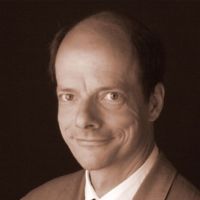AG Dalhoff
The both key research areas detailed below apply the classic engineering approach of modelling the hearing pathway in the spaces of frequency, time and level (to account for nonlinearity) for validation and development of new diagnostic methods, especially, but not only, distortion-product otoacoustic emissions (DPOAE), and the development of active acoustical implants that drive the pathway mechanically.
Head of the group

Dr.-Ing. Ernst Dalhoff
Phone number: +49 7071-29-88232
E-mail address: ernst.dalhoff@uni-tuebingen.de
Contact
Diagnostic & Implant group
Department of Otolaryngology - Head and Neck Surgery
University Hospital Tübingen
Elfriede-Aulhorn-Str. 5
72076 Tübingen, Germany
Research Areas
Audiometry, DPOAE in humans
Clinical audiometry comprises subjective (e.g. tone speech audiometry) and objective methods (no patient action required): acoustical impedance measurements at the pathway's input (tympanometry, stapedial reflex audiometry), otoacoustic emissions (TEOAE, DPOAE), and electrophysiological methods (ABR, ASSR). Currently, we concentrate on distortion-product otoacoustic emissions (DPOAE), but include other methods for control or further development.
Very simplistically, one can regard cochlea and the so-called cochlear amplifier as the middle element of the hearing path. The cochlear amplifier is the stage which in most cases suffers first when a patient develops hearing impairment, thereby leading to changes in otoacoustic emissions (OAE) which are a by-product of an orderly functioning amplifier. To measure OAE, one needs a speaker and a microphone in the ear canal. Thus, OAE are produced in the cochlea, but depend also on middle-ear transmission. DPOAE are special, because:
1) Nowadays in research one can reliably separate the primary-source component and obtains a highly robust frequency-specific measure, and
2) It appears now to be possible to separate the middle-ear component, leading to a measure which is specific for the state of the cochlea.
Moreover, by some manipulations during the experiment, it appears feasible to measure also the neural activity up to the brainstem, because efferent fibers project back to the outer hair cells and lead to a measurable inhibitory adaptation of cochlear amplification and the DPOAE. Thus, DPOAE are ideally suited to diagnose differentially pathologies of the whole pathway up to the brainstem.
Challenge and Goal
The challenge is to find diagnostic paradigms characterizing single blocks of the hearing pathway with high accuracy and in reasonable time. A most important topic is how accuracy of any such diagnosis can be ascertained. Contrary to animal experiments, where system output can be tapped by electrodes in the neural part of the system, or by laser-Doppler-vibrometric measurements of vibrating structures in the cochlea, in most cases, a direct control is not possible in humans. Also, the intersubject variability of human subjects participating in a clinical study might be higher than in an animal experiment.
Three routes of validation that might become fruitful in the future and that go beyond a typical clinical study that compares one diagnostic measure with another which is thought to be the current gold standard, might be:
(1) Use mathematical models of the hearing pathway to objectify the conception of the hearing pathway's functioning, and check with what accuracy some intrasubject variation which can be experimentally induced behaves as predicted in all subjects;
(2) Use two or more measurement techniques and perform a reproducibility study, which may allow to separate stability of a diagnostic technique from the stability of the physiology (under certain premises with respect to independence of processes);
(3) Analyze the technical noise of a diagnostic technique, or, with other words, perform a noise analysis of the technology used as well as of the study design.
Thus, it is desirable to obtain more than one diagnostic technique that can – with some technical and physiological independence – estimate the state of the same stage.
Active acoustical implants
Currently, the majority of hearing impairments cannot be cured, but are rehabilited by prescription of a hearing aid. In cases of severe-to-profound or total hearing loss, electrical stimulation of the auditory nerve with a cochlea implant is the remaining solution for rehabilitation. In the transition region between the indication ranges of hearing aids and the cochlea implant, there is a range where active acoustical implants can be the preferable rehabilitative option. These are often known as "active middle-ear implants", are partially or totally implantable, and usually attached to some portion of the ossicular chain or the round-window membrane where they stimulate directly by mechanically vibrating the structure they are attached to. Also, if in case of chronic middle-ear pathologies conventional treatment is not successful, active middle-ear implants can be the rehabilitative option leading to the best audiological outcome.
However, beside applications with clear medical indication, there remains the dream of an implant which substitutes the hearing aid, but would be as permanent and unobtrusive as a dental implant, providing superior sound quality and optimal audiological outcome (where current hearing aids leave indeed headroom for improvement).
Moreover, solutions of the same problem but without the need for a permanent implantation are also thinkable, and the hearing contact lens might turn out to be such a solution in future.
Challenge and Goal
Challenges are manifold. Any solution trying to go beyond what conventional hearing aids can offer today need firstly to improve the audiological/sound-quality problem. Current hearing aids have limitations depending on the precise application: In case of so-called open-fit hearing aids which is the preferred and most comfortable configuration, achievable amplification at low frequencies is reduced. High-frequency amplification can also be insufficient or at least sub-optimal – typical corner frequency of effective stimulation is 5 kHz, much depending on the exact type of hearing impairment. Even in the central band, despite enormous improvement in digital hearing-aid signal-processing schemes in the last two decades, limited feedback margin can lead to insufficient amplification at certain frequencies and accompanying signal quality deterioration.
For implantable solutions, there are additional challenges, for instance to achieve the necessary miniaturization and volumetric energy density, but most importantly, to devise a scheme which in the end turns out to be implantable with stable results and not too immense/unpractical surgical requirements.
Certificates and Associations

Focus: Top National Hospital 2025

Stern: Germany's Outstanding Employers in Nursing 24/25

Quality partnership with the PKV

Family as a success factor

Pension provision for the public sector





